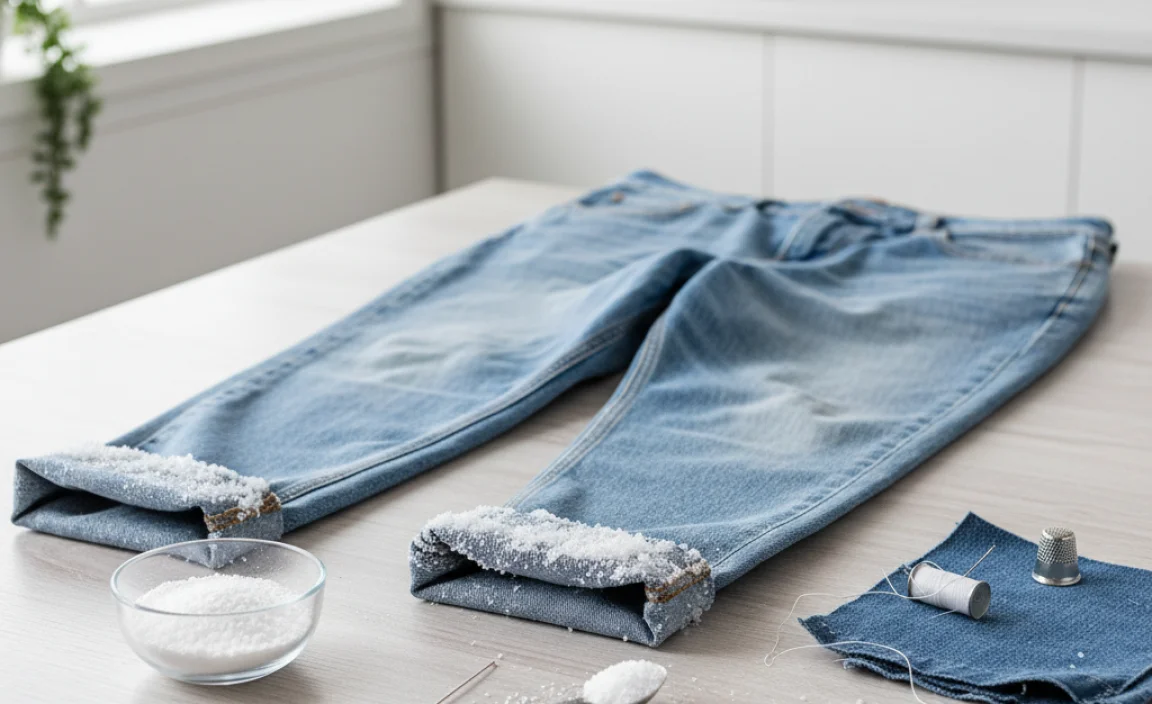Quick Summary: Learn how to hem relaxed jeans with borax for a stable, easy-to-work-with finish. Borax acts as a starch alternative, providing structure to fabric edges without a stiff feel, making your hemming process smoother and the results neater. This guide makes achieving a professional hem achievable for anyone.
How to Hem Relaxed Jeans with Borax: Essential Guide

Jeans are a wardrobe staple, but sometimes they just don’t fit perfectly. Relaxed fit jeans, in particular, can benefit from a precise hem to achieve the desired look and feel. Dealing with fabric that shifts or unravels can be frustrating when you’re trying to get that perfect length. But what if there was a simple, accessible way to make the process easier and your results cleaner? This guide will walk you through how to hem your relaxed jeans using borax, a surprising yet effective tool.
You’ll discover how borax can help stabilize the fabric, making it easier to cut and sew for a smooth finish. We’ll cover everything you need, from preparing your jeans to the final press. Get ready to achieve a professional-looking hem at home, with confidence and ease.
Understanding the Borax Method for Hemming
When it comes to hemming, precision matters. Relaxed fit jeans often have a looser weave, which can lead to fraying and shifting of threads as you work. This makes it challenging to get a clean, straight cut and an even fold. Traditional hemming techniques might involve pins, clips, or sewing aids, but there’s a less common yet effective method that uses a common household ingredient: borax.
Borax, also known as sodium tetraborate, is a natural mineral compound. While often recognized for its cleaning and laundry boosting properties, it can also serve a dual purpose in sewing. When dissolved in water and applied to fabric, borax acts like a mild stiffener or starch. It gives the fabric fibers a bit more body and structure, preventing them from spreading too much. This makes the fabric easier to handle, cut accurately, and keep in place while you’re measuring and sewing. The result is a crisper edge that’s less prone to distortion, leading to a neater, more professional hem on your relaxed jeans.
Why Use Borax for Denim Hemming?
Denim, especially the kind used in relaxed fit jeans, can be quite prone to movement. The looser weave characteristic of some relaxed fits means that fabric threads can easily shift out of place when you try to mark or cut the hemline. This can lead to crooked hems and a sloppy finish. Borax offers a unique solution by providing gentle stability.
Here’s why it’s a good option for hemming your relaxed jeans:
- Fabric Stabilization: Borax solution lightly stiffens the denim fibers. This makes the fabric easier to measure, mark, and cut accurately without it twisting or shifting.
- Reduces Fraying: By holding the weave together, borax can help minimize excessive fraying along the cut edge as you work.
- Easy to Wash Out: Unlike some permanent fabric stiffeners, borax easily washes out of the fabric with water, so it doesn’t affect the feel of your jeans after the hemming is complete.
- Cost-Effective: Borax is an inexpensive and readily available household product, making this a budget-friendly hemming solution.
- Gentle Starch Alternative: It provides enough stiffness for control without making the fabric stiff or crusty like some spray starches can.
This method is especially beneficial for beginners, as it helps to overcome the common challenge of fabric manipulation, leading to more consistent and satisfying results. It’s a practical tip that can elevate your DIY hemming projects.
Materials You’ll Need
Gathering the right tools and materials is the first step to a successful hemming project. For this borax method, you’ll need a few specific items to ensure everything goes smoothly. Having everything ready before you start will save you time and prevent interruptions during the process.
Here’s a list of what you’ll need:
- Your relaxed fit jeans
- Borax powder (found in the laundry aisle of most supermarkets)
- Warm water
- A bowl or container for the borax solution
- Measuring tape or ruler
- Fabric chalk or a washable fabric marker
- Sharp fabric scissors or a rotary cutter and mat
- Straight pins or sewing clips
- Sewing machine (or needle and thread for hand sewing)
- Matching thread
- Iron and ironing board
- Optional: A cutting mat and rotary cutter for precise lines
- Optional: A seam ripper, if you need to remove an old hem
Having a good pair of fabric scissors is crucial for a clean cut. If you have a rotary cutter and mat, they can offer even more precision, especially for thicker denim. Ensure your sewing machine is in good working order, and that you have a sturdy needle suitable for denim. Borax can be purchased at most grocery stores or online, often near laundry detergents.
Preparing Your Jeans
Before you start hemming, proper preparation is key. This ensures that your measurements are accurate and that you’re working with a clean slate. For this method, we’ll focus on preparing the denim for the borax treatment and subsequent hemming.
Follow these steps to prepare your relaxed jeans:
- Wash and Dry Your Jeans: Always start with clean jeans. Washing and drying them ensures that any shrinkage has already occurred, and you are working with the final intended dimensions of the garment. This is especially important for getting the correct hem length.
- Try Them On and Mark Your Desired Length: Put on the jeans, wearing the type of shoes you’d typically pair with them. Stand in front of a mirror. Decide precisely where you want the hem to fall. Use a fabric chalk or washable marker to mark the desired length on one leg. A good tip is to mark a single point, then check it from different angles.
- Measure and Transfer the Mark: Take off the jeans. Lay them flat on an even surface. Using your measuring tape, measure the distance from the marked point down to the bottom of the existing hem or raw edge. Transfer this measurement to the same spot on the other leg, ensuring it’s mirrored accurately. Then, draw a straight line all the way around the leg at your marked hem length. Make sure this line is perpendicular to the side seams. For extra accuracy, you can measure from the waistband down to the marked line on the inseam and outseam and transfer those measurements.
- Remove Existing Hem (If Necessary): If your jeans already have a hem you dislike or want to replace, you’ll need to remove it carefully. Use a seam ripper to pick out the stitches. Try to pull the threads free without damaging the fabric. Once the stitches are undone, gently unroll the existing hem. If there’s a significant amount of denim folded up, iron it flat.
The goal here is to have a clean, unhemmed leg that’s marked precisely for your new hemline. This careful preparation will make the subsequent steps much easier and lead to a more professional finish.
Creating the Borax Solution
The borax solution is the secret weapon for stabilizing your denim. It’s simple to make and has a significant impact on how easy the denim will be to handle. You don’t need much, and the concentration is fairly forgiving, but it’s good to get the ratio right for optimal results.
Here’s how to prepare your borax solution:
- Measure Water: You’ll need a small amount of warm water. Start with about 1 to 2 cups. The amount will depend on how much fabric you need to treat, but for a single pair of jeans, this should be plenty. Warmer water helps the borax dissolve more effectively.
- Add Borax: For 1 to 2 cups of warm water, add 1 to 2 tablespoons of borax powder. A good starting ratio is 1 tablespoon of borax per cup of water.
- Stir to Dissolve: Stir the mixture thoroughly until the borax powder is completely dissolved. You shouldn’t see any grainy residue at the bottom of your bowl. If it doesn’t dissolve easily, the water might not be warm enough, or you might need to stir for a bit longer.
- Test the Stiffness (Optional): Dip a small scrap of denim or an inconspicuous area of your jeans into the solution and let it dry. It should provide a slight stiffness, not make the fabric rigid. If it’s not stiff enough, you can add a little more borax. If it feels too stiff, add a bit more water.
Once dissolved, the solution is ready to be applied. It’s best to use it fairly soon after mixing, as the dissolving properties might change over time. Keep your bowl of solution handy, as you’ll be dipping the hem area directly into it.
Applying Borax and Preparing the Hem
With your borax solution mixed and your jeans prepared, it’s time to apply the treatment. This step is crucial for enabling clean cuts and accurate folding of your denim.
Follow these steps to apply the borax solution and prepare the hem:
- Dip the Hem Area: Take one leg of your jeans and carefully dip the bottom 2-3 inches (where you plan to create the new hem) into the borax solution. Ensure this section of fabric is thoroughly saturated. You might need to gently work the solution into the fabric with your fingers to ensure even coverage.
- Squeeze Out Excess Water: Gently squeeze out any excess solution. You want the fabric to be damp and slightly stiff, not dripping wet. This prevents excess moisture from interfering with marking and cutting.
- Repeat for the Other Leg: Do the same for the other leg of your jeans, ensuring consistent saturation and squeezing.
- Dry Slightly (Optional but Recommended): For best results, allow the treated areas to air dry for about 15-30 minutes, or until they are mostly dry to the touch but still feel slightly stiffened. You can also use a hairdryer on a low setting to speed this up. This drying time allows the borax to fully set into the fabric fibers.
- Iron the Hem Area (Optional): Once the treated section is mostly dry, you can lightly iron the area flat. This helps create a very stable base for your next steps. Be sure to iron on the wrong side of the fabric to avoid any sheen on the outside.
This treatment makes the denim much easier to control. The fibers will feel more cohesive, reducing their tendency to shift or fray excessively when you start to mark and cut. It’s like giving your denim a temporary, helpful structure.
Measuring and Cutting the New Hemline
Now that your denim is prepped with the borax solution, you can proceed to the cutting stage. The slight stiffness from the borax should make this process much more manageable.
Here’s how to measure and cut your new hemline:
- Re-check Your Markings: With the treated hem area slightly stiffened, re-check your original markings for the desired hem length. Ensure your lines are still visible and clear.
- Measure and Mark the Cut Line: Decide how much length you want to fold up for the hem. A common hem allowance for jeans is 1 to 1.5 inches. Measure this amount up from your desired finished hemline mark, and draw a new cutting line. This is the line you will cut along. Make sure this line is straight and perfectly parallel to your original hemline.
- Cut the Fabric: Using your sharp fabric scissors or rotary cutter and mat, carefully cut along the cutting line you just marked. Take your time to ensure a straight and clean cut. The borax treatment should help prevent the fabric from bunching or shifting as you cut.
- Trim Any Loose Threads: After cutting, look for any stray threads along the cut edge. Trim them neatly with your scissors.
You now have a clean, precisely cut edge ready for folding. The borax treatment should have kept the denim stable enough for this accurate cut. This sets you up for a neat fold and stitching.
Folding and Pressing the Hem
With the denim cut to the correct length, it’s time to create the actual hem fold. This step requires precision to ensure an even and professional finish. The borax treatment will be your ally here, keeping the fabric edges from being unruly.
Here’s how to fold and press your hem:
- First Fold: Take the cut edge of the denim and fold it upwards towards the inside of the leg, aligning it with your original marked finished hemline. This creates a roughly 1 to 1.5-inch fold (depending on your cut). Press this fold firmly with your iron. The borax should help the fabric hold this crease well.
- Second Fold: Now, fold the fabric up again, encasing the raw edge. This second fold should be just wide enough to cover the raw edge and meet the first fold you just pressed. Aim for this second fold to be consistent in width all the way around the leg. Press this final fold very firmly with your iron.
- Check for Evenness: As you press, continuously check that the fold is even and that the raw edge is completely enclosed within the second fold. Smooth out any wrinkles or puckers with your fingers and the iron.
- Pin in Place: Once you are satisfied with the folded and pressed hem, secure it in place with straight pins or sewing clips. Place pins perpendicular to the folded edge, about every 1-2 inches, to keep it from shifting while you sew.
The goal is to have a perfectly folded, pressed, and pinned hem ready for stitching. The borax will have made these crisp folds much easier to achieve and hold.
Sewing the Hem
This is where your hem starts to become permanent. Whether you’re using a sewing machine or hand-stitching, the goal is a secure and neat stitch that matches the original look of your jeans as closely as possible.
Here are the steps for sewing your hem:
- Prepare Your Sewing Machine:
- Thread Selection: Use a strong thread that matches the color of your jeans. For a classic denim look, you might opt for a thicker, contrasting thread (like gold or orange) if your jeans have this detail.
- Needle: Ensure you are using a denim needle (size 90/14 or 100/16 is usually appropriate) to penetrate the thick fabric.
- Stitch Selection: A straight stitch is standard. Set your stitch length to be slightly longer than usual (around 2.5-3.0mm) for thicker fabrics like denim.
- Starting Point: It’s often easiest to start sewing on an inseam or outseam, where the fabric is thinner.
- Pin Removal: Remove pins as you approach them while sewing to avoid damaging your machine.
- Sewing the Hem: Sew as close to the folded edge as possible, following the line of the previous hem or about 1/8 inch from the top folded edge. Sew slowly and steadily, guiding the fabric with your hands.
- Reinforce the Start/End: Backstitch at the beginning and end of your seam to secure the stitches and prevent them from unraveling. For extra durability, you can sew over the seam a second time, especially over the start and end points.
- Stitch Type: Use a sturdy stitch like a backstitch or a hemming stitch.
- Consistency: Aim for small, consistent stitches that are tightly spaced to hold the denim securely.
- Patience: This method requires considerably more time and effort but can yield excellent results if done carefully.
The borax treatment should have kept the hem from shifting significantly, making the sewing process much smoother. You should have a securely attached hem that looks neat and professional.
Final Pressing and Finishing Touches
The last step in the hemming process is crucial for a polished look. A final press not only sets the stitches but also gives your newly hemmed jeans that professional finish you’re aiming for.
Here’s how to finish your hemming project:
- Iron Again: Turn the jeans inside out. Press the newly sewn hem from the inside, ensuring the seam allowance lies flat. Then, turn the jeans right side out and give the outside of the hem a final press. Use your iron to smooth any potential puckers or unevenness.
- Check Stitches: Inspect your stitching for consistency and security. Ensure there are no loose threads or skipped stitches that need attention.
- Wash (Optional): To remove any residual borax and to give the jeans a final softened feel, you can wash them as you normally would. The borax solution is designed to wash out











